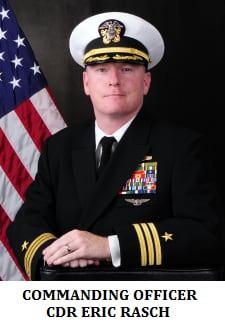The head of a riverine squadron at the center of an international incident in January was fired Thursday, the first officer to be publicly disciplined for a series of errors that led to 10 sailors being captured by Iran after getting lost in the Persian Gulf — a debacle that nearly scuttled the U.S.-Iran nuclear deal at the 11th hour.
Cmdr. Eric Rasch, who at the time of the Jan. 12 incident was the executive officer of the Coastal Riverine Squadron 3, during the Jan. 12 debacle, was removed from his job by Capt. Gary Leigh, head of Coastal Riverine Group 1, for what a Navy Expeditionary Combat Command release said was "a loss of confidence" in his ability to remain in command.
"Capt. Gary Leigh, commander, CRG-1, made this determination following his review of a preliminary investigation into the incident near Farsi Island in the Arabian Gulf, Jan. 12-13, involving 10 CRS-3 Sailors," the release said. "Rasch was assigned as the executive officer of CRS-3 during this time-frame."
Cmdr. Gregory Meyer, who was commanding officer at the time of the incident, is currently with Coastal Riverine Group 1, and has been put on "administrative hold," meaning the Navy will not transfer him out of the unit, while a high-level review of the Navy’s investigation into the incident continues, said two officials familiar with speaking on background to discuss internal deliberations.
The move is only the first in what sources say is expected to be a series of disciplinary measures to be meted out for what was a high-profile embarrassment for the U.S. Navy. The 10 riverines were captured and their high-speed special mission boats vessels were seized captured when they their boat drifted into Iranian waters around Farsi Island, a remote Iranian military outpost in the middle of the Persian Gulf. During their 16 hour detention, one of the U.S. sailors appeared to apologize while being videotaped, which became part of the flurry of Iranian propaganda publicized in the wake of the arrests.
The investigation is still under review and is expected to be released by the end of May, said two Navy officials. The Navy is
Navy officials believe that a navigational error, along with some baffling errors in judgment on the part of the crew, led to their capture. Officials have suggested posited that the crew may have been taking an unauthorized ill-advised shortcut through Iranian waters to meet up with a U.S. Coast Guard vessel that they were scheduled to rendezvous with for refueling.
Rasch has been reassigned temporarily to Riverine Group 1. Capt. Stanfield Chien has assumed command of Riverine Squadron 3 until a replacement is named. There are about 400 sailors in CRS-3.
Leigh made the call to fire Rasch because the findings showed the officer "failed to provide effective leadership," which led to a lack of effective oversight.
Rasch is a prior-enlisted officer who joined the Navy in 1989 as an intelligence specialist. He was commissioned after graduating from the University of San Diego in 2003 and has been a career destroyer officer. He has served on the destroyers Benfold, Hopper and Sampson.

Cmdr. Eric Rasch
Photo Credit: Navy
His shore tours include a spin with the 504th Battlefield Surveillance Brigade in Tal'Afar, Iraq, during Operation Iraqi Freedom, and a tour at Naval Surface Force Pacific in San Diego.
The investigation into the Farsi Island incident has been under review for months now and the duration has prompted some lawmakers to question why the Navy was taking so long to release it.
In February, the chairman of the Senate Armed Services Committee, Sen. John McCain, R-Ariz., threatened to subpoena the captured riverines if the Navy didn't release the investigation findings promptly.
That sent Navy officials scrambling to Capitol Hill to brief the findings behind closed doors while the Navy continued its review process, according to sources familiar with the exchange.
David B. Larter was the naval warfare reporter for Defense News.
